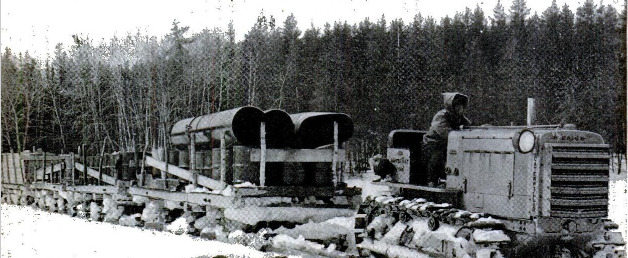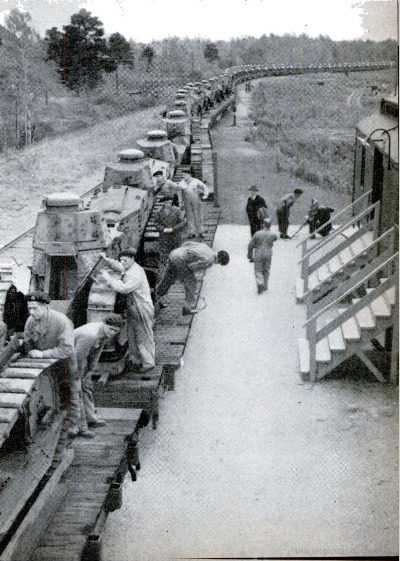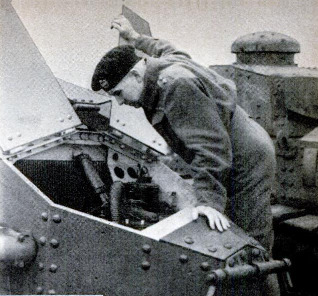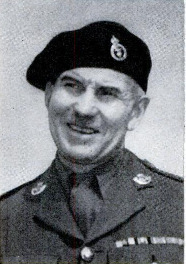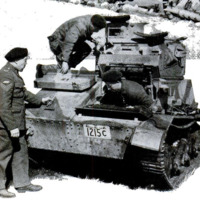-
Title (Dublin Core)
-
Canada rallies her cat man: North woods tractor drivers summoned to run war tanks
-
Article Title and/or Image Caption (Dublin Core)
-
Title: Canada rallies her cat man: North woods tractor drivers summoned to run war tanks
-
extracted text (Extract Text)
-
FIFTY degrees below zero, a blizzard
blowing, and 200 miles to go. Over froz-
en muskeg bogs, down creek beds, and
up through the bush over rugged moraines
go the drivers of the tractor trains, all
through the wild Canadian winter, freight-
ing machinery and
supplies to the new
gold mines of the
northern canoe coun-
try.
For this kind of
mushing, which in
recent years has
conquered the
swampy wilderness
for heavy traffic, a
man has got to be
tough. But especial-
ly he’s got to be
good. That's why
he’s sure to make a real tank soldier.
The far north's new breed of musher is
called a cat-skinner. Up around God's Lake
and Hudson Bay there aren't so many cat-
skinners this winter. They've been joining
the Canadian Army in droves, and as soon
as they can get a proper rig of machinery
they are figuring on starting for Berlin.
After all, a tank is nothing but an over-
grown, armored cat—with some teeth in it.
At his peacetime job, the cat-skinner
rides the cab of a six-ton Caterpillar tractor
over trails marked by poles in the drifted
snow, with six sleds and a caboose behind
and maybe fifty tons of precious freight.
On his cat he carries a spare radiator and
six barrels of gas. He uses fuel oil for anti-
freeze and he keeps his engine running for
five or six days at a stretch. If it breaks
down on him, he rigs a tent over his cat,
installs a stove, takes a chew of tobacco
and a monkey wrench, and fixes things right
on the spot. When he starts out with a cat
train, he gets there and he brings it back.
You'll find these north-country men today
in a sandy wilderness of tar-paper shacks
called Camp Borden, up between Lake Sim-
coe and Georgian Bay, north of Toronto—
tinkering with those 200 World War tanks
which the U. S. Army sent to Canada a few
weeks ago.
‘With them are cat-skinners from the
western construction crews, drag-line men,
clamshell men, bulldozer
men. And hundreds of boys
from the farms of Manitoba
and Saskatchewan, who
know their gas engines and
Diesels too. If a lad is trac-
toring a section of wheat
land twenty miles from the
railroad, he can’t call the
garage when something
goes wrong. And when that
lad goes to town, he drives
his own jallopy.
One look at those old
tanks we sent to Canada
would give Hitler a belly
laugh, but another look at
the men who are handling
them would tone it down.
Just let the R. A. F. and
London hold out long
enough for the tank fac-
tories to get going, and the
Panzer divisions will have
something to tangle with.
Take the Fort Garry
Horse, for instance. That's
a cavalry regiment from
Manitoba, named for the
old frontier post which be-
came Winnipeg. In the last
war it dashed behind the
old frontier post which be-
came Winnipeg. In the last
war it dashed behind the
lines and put a German
field battery out of action,
the old hell buggies were, they gave the men
something to work on, a means of learning
to drive and navigate cross-country, and
even for group maneuvers later on. With
them these empty-handed regiments could
‘be turned into going concerns.
Bright and early the Fort
Garry horsemen were on hand
at the depot to get their
quota of forty tanks. Experi-
enced tank men, there to
show the troopers what to do,
just stood by with surprised
looks on their faces. The
cavalrymen hitched up a few
hose connections, poured a
little gas ih the vacuum
tanks, twisted the cranks,
climbed aboard, and simply
drove the cats away.
“Ride 'em, cowboys!" some-
body cried—and they did.
These little six-ton, two-
man tanks (American-made
on the Renault model) were tough-look-
ing babies, weathered for more than
twenty years in a parking lot at Fort
George G. Meade in Maryland, many
of their hulls and turrets pitted with
machine-gun marks, presumably from
the last war. They clattered along on
wide steel plates with heavy lugs (a
far cry from the flexible chainlike links
of speedy modern tracks) which slapped
on the ground and limited speed to six
miles an hour. But the engines and
running gear were O.K.; they had been
greased up well when put away. And
if the old-style tracks were good for
only 150 miles on these sands at Camp
Borden, that was fine. So much more
repair work to be done in the winter.
Back at their own quar-
ters, the Fort Garry boys
went to work. Within
three days, twenty-five of
those forty tanks were out
in line, purring like kit-
tens, and the rest were
well on the way.
The boys clattered up
and down in the open
spaces among the bar-
racks. For a man who has
driven a car there are only
a few things to catch onto.
The controls are almost
the same as a car's, except
that you practically sit on
the floor and instead of a
wheel you have two clutch
levers, one for each track.
Pull back the right lever,
it disengages the clutch of
the right tread and turns
you in that direction. Un-
like most cats, a still
harder pull brakes the track, and you make
a hairpin turn. It is in rough country that
the cat man's skill comes into play. There
the novice can easily tip over a fast tank,
perhaps kill his passenger if the turret
above is open. But the experienced man will
instinctively spin her when she tips, quickly
turn her nose straight down the grade.
Anyway, the boys took to the equipment
like ducklings to a mud puddle. And old
horse soldiers happily realized something:
the Northwest still breeds good horse riders;
but the same lads are part of a whole gen-
eration which has grown up in North
America since the last war, a generation
which practically cut its teeth on a spark
plug and was weaned on a carburetor.
‘That is something worth remembering in
these gloomy war days. Since the disasters
of last May, all of us have been centering
our thoughts on aviation, on assembly lines,
machine tools, and crafts-
men who can split a thou-
sandth of an inch. These
things are all important,
and military aviators have
to know their trigonom-
etry. But when armored
vehicles are produced, it's
going to be the back-yard and the back-
country mechanics who fight with them. If
Britain is to win, there will be more war on
the continent. And whether they take off
from the Near East or from a beach-head
on the Channel, that's when you're likely
to hear more of Canada’s cat-skinners, and
of their salty, peppery, pint-sized com-
mander, Col. F. F. Worthington.
This is one of those sad, pathetic tales
of unpreparedness, though it now may have
a satisfactory ending. Worthy, as they call
him all up and down Canada, was his coun-
try’s bug on mechanized equipment, one of
those prophets without honor which every
country seems to have. The United States
had Billy Mitchell, France had De Gaulle,
and quite possibly in Germany today there
is some ignored seer telling Hitler why he
is going to lose the war.
‘When the first World War broke out,
Scottish-born Worthington was a young
adventurer in Central America—ship’s
engineer, mining engineer, and ma-
chine-gunner. Fresh from fighting
against Villa for Madero, he went up to
Canada and enlisted in the Black Watch.
In France he was four times decorated
for deeds which he will now describe
only as “self-preservation.” He wound
up the war as a captain in one of the
world’s pioneer armored-car outfits,
known as Brutinel's Brigade.
Gen. Raymond Brutinel was a French
engineer, living in Canada, who early
in the last war foresaw the coming of
armored, mechanized warfare. His idea
was so outlandish that his outfit had
to be equipped by private subscription,
with guns obtained in various ways,
sometimes illegal. Its original equip-
ment was a two-cylinder Autocar truck,
with a steel box built around it, mount-
ing two Colt machine guns. When the masses
of British tanks broke through the line
on August 8, 1918, which Ludendorff called
Germany's blackest day, Brutinel's Brigade
came close behind, with machine guns on
trucks, motorcycle side cars and trucks.
The battle plan for that day followed pre-
cisely the tactics used last June by the
German armored divisions in France. Bru-
tinel's column was to have dashed through
and grabbed Roye, a rail center. But the
battle that was visualized never quite came
off, because the higher command was wor-
ried about protecting the flanks.
“But that was a tank battle, identical
with what the Hun has done now,” Colonel
‘Worthington recalls today. “We showed the
bugger the way. It boils me up. It's almost
a shame he didn't have more tanks then,
so we'd have remembered.”
WORTHINGTON remembered the!
ome When Canada after the war
became even more demilitarized than the
United States, he stayed on with the skele-
ton army, waiting for the war he knew was
coming. Worthy was a very popular fellow,
but was always talking tanks and mecha-
nized warfare. Kind of eccentric on the
subject. Or so people thought.
Four years ago the Canadian Army es-
tablished a “tank school” with Worthington:
in command. In the spring of 1938 he set up,
in a few shacks in the deserted sands of
Camp Borden, the Canadian Armoured
Fighting Vehicles Training Centre, C.A.S.F. |
With the beginning of the war, groups of
officers and men from tank regiments of
the active militia were rushed in for train-
ing in tactics, radio, gunnery, and driving
and maintenance, so they could go back to
their own outfits and pass on the knowledge.
Even so, lack of equipment made it neces-
sary to do much training with gadgets sub-
stituting for the real thing. Most ingenious
of these is a device called a “rypa,” a turret
which jolts and pitches like the jouncing of
a tank, from which the gunner shoots air-
rifle pellets down a sand-pit range.
The lowlands blitzkrieg of last May sud-
denly brought to Canada the realization
that it had done hardly anything about tank
warfare. Tank building got under way al-
most immediately, in the Canadian Pacific
Railway shops. Nothing is being said about
when the new tanks will be delivered, or
what they will be like. But a contract was
recently let for nine carloads of pins for
caterpiller tracks.
‘Well, I went up to Camp Borden to find
out what in the world a nation at war
wanted with those old World War clunks,
and this story is what I found out. It is a
Canadian story, but in many ways it might
be a story of the United States, too. Our
armored vehicles are also on order, and in
army maneuvers we use ice trucks. But
then again we have our own cat-skinners,
and our lads from the mechanized farms,
and the boys fixing their flivvers in the
back yards—millions more of them than
Canada. A lot of them will be getting to-
gether in barracks this winter, eager for
machinery to work with. And it begins to
look as though, in due course, they will be
getting it.
At any rate, once the present excitement
about production is over, we are going to
realize strongly that there is a lot more in
preparedness than machine tools. We're go-
ing to realize that the used-car lot and the
despised jallopy are among the strongest
links in our national defense. You can learn
a lot from an old piece of machinery.
-
Contributor (Dublin Core)
-
Hickman Powell (article writer)
-
Language (Dublin Core)
-
Eng
-
Date Issued (Dublin Core)
-
1941-01
-
pages (Bibliographic Ontology)
-
76-80
-
Rights (Dublin Core)
-
Public domain
-
Archived by (Dublin Core)
-
Sami Akbiyik
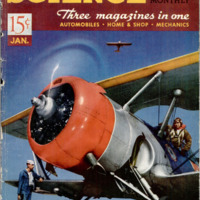 Popular Science Monthly, v. 138, n. 1, 1941
Popular Science Monthly, v. 138, n. 1, 1941


